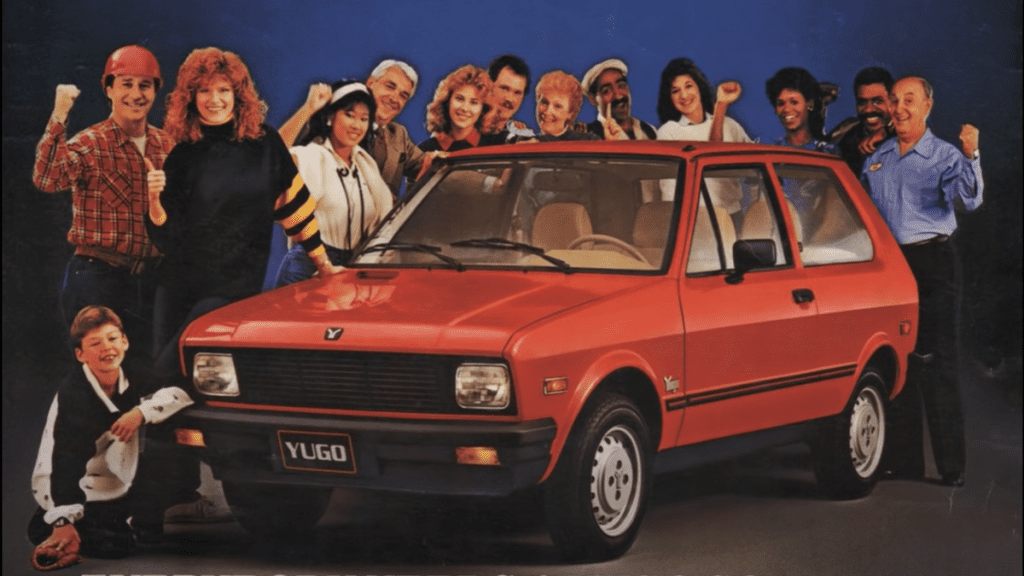A Former Yugo Seller Explains That the Cars Weren't Always Hated

The Yugo gets a bad rep. It’s frequently given the title of Worst Car in History, and many will tell you that its reputation is entirely earned. Its popular image is that of a cheap, rattly hunk of junk that wasn’t built to last. That wasn’t the view that Yugo’s U.S. customers held — they saw a cheap, practical vehicle that could serve their daily needs. It was only after a few years on the American market that the Yugo began to draw vitriol, trampled under financial and supply-chain issues.
That’s how Daryll Rardon remembers it. He would know — he sold brand-new Yugos back in the 1980s. He saw the initial acceptance around the budget-friendly hatchback and watched as public perception of the Yugo soured. This week, Rardon offered some insight into his experience selling Yugos on Twitter, but I wanted to delve deeper into the car’s earliest, brightest days. So I gave him a call.
Photo: Daniel Kruczynski, CC BY-SA 2.0 , via Wikimedia Commons
According to Rardon, the Yugo’s appeal was simple: “They’re the same price as a motorcycle and your feet don’t get wet,” he told me. With an MSRP around $4,000 (equivalent to roughly $10,900 in 2022 dollars), it was the cheapest new car in American when it arrived here in 1986. A value proposition like that usually hooks younger or lower-income buyers, and Rardon said that’s exactly who darkened the door of his dealership — Precision Imports in Tampa, Florida, where Rardon worked from 1986 until the shop sold its Yugo franchise the following year.
First-time car buyers, people upgrading from motorcycles, anyone who needed cheap, efficient transportation — these were the typical Yugo buyers. The hatchback competed with used cars on price, but but it could offer something no used car had: A warranty.
G/O Media may get a commission
While the rock-bottom price got people to walk into a Yugo showroom, Rardon explained that the car made a strong first impression with customers. Yugo built its cars with more metal than the typical economy car of the time (in part to make up for poor materials), which gave the cars a sturdy, well-built feel. In Rardon’s words, “It was a decent little hatchback.” There were some peculiarities to the car, of course: Rardon described the seats as being a “weird, terrycloth towel material,” and told me “God couldn’t find Reverse in a Yugo,” but overall, the cars made a solid enough case for themselves.
I found it, it’s right therePhoto: CC BY-SA 2.0 , via Wikimedia Commons
It was only after the cars left the showroom that the problems started to show up. Yugos required more frequent maintenance than most conventional cars of the time, including some quirks inherited from Fiat. In particular, the cable that operated the clutch was prone to snapping, a problem that often reared its head before the first test drive: Rardon told me dealer mechanics often had to replace clutch cables to get cars off the delivery truck when they arrived.
As time and miles passed, it became a chore to maintain a Yugo. Parts were often scarce, and a lack of factory support from Yugoslavia left dealers in a tight spot. Rardon’s dealership sent technicians over to the local Fiat showroom on more than one occasion to pick up parts that could be shared between the two brands. Of course, in our modern world of failing global supply chains, is it any wonder that 40 years ago a small car company struggled to ship parts halfway around the planet?
Presumably, a dealer could keep a Yugo running off-road tooPhoto: Tonystarkv42, CC BY-SA 4.0 , via Wikimedia Commons
“If the dealer was good, they could keep them running on the road,” Rardon told me. But with time, those dealers fell out of love with the little car. Precision Imports sold Yugos alongside Saabs, Peugeots, and Isuzus, three offbeat marques whose sales couldn’t exactly fund a fourth, unprofitable brand. If Yugo was going to stay on the dealer’s lot, the brand would need to pull its weight. On a low-price car, that was tricky.
To get pricing under $4,000, showrooms had to live with tight profit margins on the little hatchbacks. Some dealers bolstered their numbers by offering price-gouging accessories, while others sought to make the difference through financing. That latter plan worked for a time, but it didn’t take long for banks to develop a distaste for the Yugo. Low resale values, combined with the often-spotty credit history of the brand’s core customers, led financiers to start raising interest rates on America’s cheapest car.
“Once they became a pariah with the banks, it was over,” Rardon told me. Financing was no longer a money maker for dealers. In the case of Precison Imports, profit, not reliability or reputation, is what drove the shop to sell off its Yugo franchise. The cars only made money when they returned for service, and that wasn’t enough to justify a spot on the showroom floor.
Photo: Michael Gil from Toronto, ON, Canada, CC BY 2.0 , via Wikimedia Commons
Yugos were built to be basic, functional transportation for a rock-bottom price — a price that many Americans happily paid. But the cars needed dealers to survive, and when banks make those low-price vehicles unprofitable, dealers quickly found it hard to justify keeping the brand around. It’s no wonder Yugo died, but it’s worth remembering that the brand’s death was never the car’s fault.





